East Asian cultural sphere
The East Asian cultural sphere, Chinese cultural sphere or Sinosphere (alternatively called Sinic/Sinitic world, Confucian world, Taoist world or Chinese character cultural sphere) encompasses the countries within North, East and Southeast Asia that were influenced by Chinese culture both historically and present. The region is not to be confused with Greater China, a region that encompasses countries with majority Han Chinese or Chinese-speaking populations.[1]
| Sinosphere | |
|---|---|
 Chinese cultural extent Dark blue: East Asian cultural sphere (Bhutan, Mainland China, Hong Kong, Japan, Macau, Mongolia, North Korea, Singapore, South Korea, Taiwan and Vietnam) Light blue: Regions culturally linked to China both historical and present, notably Assam, Arunachal Pradesh, Brunei, Cambodia, Christmas Island, East Timor, Indonesia, Kalmykia, Kazakhstan, Kyrgyzstan, Laos, Malaysia, Manipur, Meghalaya, Mizoram, Myanmar (Burma), Nagaland, Nepal, Outer Manchuria, Philippines, Siberia, Sikkim, Sri Lanka, Tajikistan, Thailand, Tripura, Turkmenistan, and Uzbekistan | |
| East and Southeast Asia | |
| Sinicized Kingdoms | Baekje, Goryeo, Joseon, Kamakura, Lanfang, Silla, Vietnam |
| Transmission of Han Buddhism | Bhutan, China, Japan, Korea, Mongolia, Malaysia, Singapore, Tibet, Vietnam |
| Central Asia and the Caucasus | |
| Buddhist monasticism | Afghanistan, Kalmykia, Uzbekistan |
| Greater China · Buddhist texts · Folklore of China | |
| East Asian cultural sphere | |||||||||||||||||||||||||||||
|---|---|---|---|---|---|---|---|---|---|---|---|---|---|---|---|---|---|---|---|---|---|---|---|---|---|---|---|---|---|
| Chinese name | |||||||||||||||||||||||||||||
| Traditional Chinese | 東亞文化圈 漢字文化圈 | ||||||||||||||||||||||||||||
| Simplified Chinese | 东亚文化圈 汉字文化圈 | ||||||||||||||||||||||||||||
| |||||||||||||||||||||||||||||
| Vietnamese name | |||||||||||||||||||||||||||||
| Vietnamese alphabet | Vùng văn hóa Đông Á Vùng văn hóa chữ Hán Đông Á văn hóa quyển Hán tự văn hóa quyển | ||||||||||||||||||||||||||||
| Hán-Nôm | 塳文化東亞 塳文化𡨸漢 東亞文化圈 漢字文化圈 | ||||||||||||||||||||||||||||
| Korean name | |||||||||||||||||||||||||||||
| Hangul | 동아문화권 한자문화권 | ||||||||||||||||||||||||||||
| Hanja | 東亞文化圈 漢字文化圈 | ||||||||||||||||||||||||||||
| |||||||||||||||||||||||||||||
| Japanese name | |||||||||||||||||||||||||||||
| Kanji | 東亜文化圏 漢字文化圏 | ||||||||||||||||||||||||||||
| Hiragana | とうあぶんかけん かんじぶんかけん | ||||||||||||||||||||||||||||
| |||||||||||||||||||||||||||||
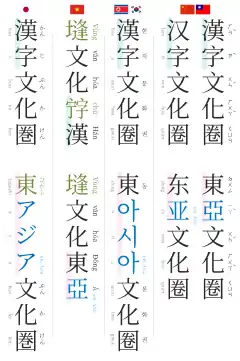

The principal culture of the East Asian cultural sphere is Chinese culture, with Japanese culture, Korean culture and Vietnamese culture lying on the peripheries. In particular, Japan, Korea and Vietnam were prominent tributary states of China from the 14th to 19th centuries following extensive prior interactions, and the regions directly south of China, now most commonly known as Southeast Asia, was referred to as Nanyang ("southern ocean").[2] Shared features of countries within the East Asian cultural sphere include their philosophies, beliefs, religions, political structures, social institutions, laws, rituals, military doctrines, medicine, science, literature, art, cuisine, architecture and so on. Common belief systems throughout the region include Confucianism, Buddhism (especially East Asian Buddhism) and Taoism.[1] The process of adopting elements of Chinese culture is called Sinicization.
The Classical Chinese language, a logographic script originating from ancient China, became an early regional lingua franca in the written form and, as such, was a major facilitator of cultural exchange throughout the region up until the early 20th century. Other important language scripts of the region include Katakana from Japan, Hangul from Korea, and to a lesser extent, Chữ Nôm from Vietnam.[3] Japan, Korea and Vietnam also exerted their own influence onto Chinese culture, transforming both the Chinese language as well as the concepts it entailed.[4][5] These countries not only received Chinese culture, but actively participated in the creative process of cultural interaction, exchange, and reinvention.[1]
The historical prevalence of Chinese traditions and practices has extended to other countries outside of those aforementioned. Regional overseas Chinese communities have played an important role in spreading Chinese culture throughout South and Southeast Asian nations such as Cambodia, Indonesia, Laos, Malaysia, Myanmar (Burma), the Philippines, Sri Lanka and Thailand throughout the 18th–20th centuries. Examples include the spread of Chinese architecture throughout the region, as well as the extent of Chinese folk religion in Southeast Asia.[6][7][8][9][10] Recent waves of Chinese migrants have led to the emergence of large contemporary Han Chinese communities in numerous major cities throughout these countries, notably Sihanoukville in Cambodia, the Malaysian cities of George Town in Penang, Malacca City in Malacca as well as its capital Kuala Lumpur, and Mandalay in Myanmar.[11][12] Furthermore, places such as Singapore are Chinese-majority countries, largely settling between the 15th and 17th centuries, where they are also known as the Peranakans or Straits Chinese.
The concept of the East Asian cultural sphere is comparable to conceptions of the Arab world, Greater India, Greater Iran, Latin world, Turkic world, Western world and so on where a multitude of peoples or countries share a number of cultural, linguistic and religious similarities due to proximity or shared history.
Terminology
China is regarded as one of the cradles of civilization, with the emergent cultures that arose from the migration of original Han settlers from the Yellow River generally regarded as the starting point of the East Asian world. Today, its population is approximately 1.43 billion.
Japanese historian Nishijima Sadao (1919–1998), professor emeritus at the University of Tokyo, originally coined the term Tōa bunka-ken (東亜文化圏, 'East Asian Cultural Area'), conceiving of a Chinese or East-Asian cultural sphere distinct from the cultures of the west. According to Nishijima, this cultural sphere—which includes China, Japan, Korea, and Vietnam, stretching from areas between Mongolia and the Himalayas—shared the philosophy of Confucianism, the religion of Buddhism, and similar political and social structures.[13]
Etymology
Sometimes used as a synonym for the East-Asian cultural sphere, the term Sinosphere derives from Sino- ('China, Chinese') and -sphere, in the sense of a sphere of influence (i.e., an area influenced by a country). (cf. Sinophone.)
As cognates of each other, the "CJKV" languages—Chinese, Japanese, Korean, and Vietnamese—translate the English term sphere as:
- Chinese: quān (圈, 'circle, ring, corral, pen')[1]
- Japanese: ken (圏けん, 'sphere, circle, range, radius')[1]
- Korean: gwon (권)[1]
- Vietnamese: quyển / khuyên[1]
Victor H. Mair discussed the origins of these "culture sphere" terms.[14] The Chinese wénhuà quān (文化圈) dates back to a 1941 translation for the German term Kulturkreis, ('culture circle, field'), which the Austrian ethnologists Fritz Graebner and Wilhelm Schmidt proposed. Japanese historian Nishijima Sadao coined the expressions Kanji bunka ken (漢字文化圏, "Chinese-character culture sphere") and Chuka bunka ken (中華文化圏, "Chinese culture sphere"), which China later re-borrowed as loanwords. Nishijima devised these Sinitic "cultural spheres" within his Theory of an East Asian World (東アジア世界論, Higashi Ajia sekai-ron).[1]
Chinese–English dictionaries provide similar translations of this keyword wénhuà quān (文化圈) as "the intellectual or literary circles" (Liang Shiqiu 1975) and "literary, educational circles" (Lin Yutang 1972).
The Sinosphere may be taken to be synonymous to Ancient China and its descendant civilizations as well as the "Far Eastern civilizations" (the Mainland and the Japanese ones). In the 1930s in A Study of History, the Sinosphere along with the Western, Islamic, Eastern Orthodox, Indic, etc. civilizations is presented as among the major "units of study."[15]
Comparisons with the West
British historian Arnold J. Toynbee listed the Far Eastern civilization as one of the main civilizations outlined in his book, A Study of History. He included Japan and Korea in his definition of "Far Eastern civilization" and proposed that they grew out of the "Sinic civilization" that originated in the Yellow River basin.[16] Toynbee compared the relationship between the Sinic and Far Eastern civilization with that of the Hellenic and Western civilizations, which had an "apparentation-affiliation."[17]
American Sinologist and historian Edwin O. Reischauer also grouped China, Korea, and Japan into a cultural sphere that he called the Sinic world, a group of centralized states that share a Confucian ethical philosophy. Reischauer states that this culture originated in Northern China, comparing the relationship between Northern China and East Asia to that of Greco-Roman civilization and Europe. The elites of East Asia were tied together through a common written language based on Chinese characters, much in the way that Latin had functioned in Europe.[18]
American political scientist Samuel P. Huntington considered the Sinic world as one of many civilizations in his book The Clash of Civilizations. He notes that "all scholars recognize the existence of either a single distinct Chinese civilization dating back to at least 1500 B.C. and perhaps a thousand years earlier, or of two Chinese civilizations one succeeding the other in the early centuries of the Christian epoch."[19] Huntington's Sinic civilization includes China, North Korea, South Korea, Mongolia, Vietnam and Chinese communities in Southeast Asia.[20] Japan is not included. Of the many civilizations that Huntington discusses, the Sinic world is the only one that is based on a cultural, rather than religious, identity.[21] Huntington's theory was that in a post-Cold War world, humanity "[identifies] with cultural groups: tribes, ethnic groups, religious communities [and] at the broadest level, civilizations."[22][23]
Culture

Arts
- Architecture: Countries from the East Asian cultural sphere share a common architectural style stemming from the architecture of ancient China.[24]
- Calligraphy: Caoshu is a cursive script-style used in Chinese and East Asian calligraphy.
- Cinema: see, Hong Kong cinema, Taiwanese cinema, Chinese cinema, Japanese cinema, Korean cinema, Vietnamese cinema.
- Martial Arts: see, Gōngfu (kung fu), Kuntao, Karate, Taekwondo, Jūdō, Sumo, Nhất Nam, and Vovinam
- Music: Chinese musical instruments, such as erhu, have influenced those of Korea, Japan, and Vietnam.
Cuisine
The cuisine of East Asia shares many of the same ingredients and techniques. Chopsticks are used as an eating utensil in all of the core East Asian countries. The use of soy sauce, which is made from fermenting soybeans, is also widespread in the region.[25]
Rice (米飯; mǐfàn) is a main staple food in all of East Asia and is a major focus of food security.[26] Moreover, in East Asian countries, the word for 'cooked rice' (飯; fàn) can embody the meaning of food in general.[25]
Popular terms associated with East Asian cuisine include kimchi (泡菜; pàocài), sushi (壽司; shòusī), hot pot (火鍋; huǒguō), tea (茶; chá), dumplings (餃子; jiǎozi), dimsum (點心; diǎnxīn), noodles (麵; miàn) / ramen, as well as phở, sashimi, wasabi, udon, among others.[27]
Traditions
- Fashion: see, Hanfu, Cheongsam (or Qipao), Áo dài, Hanbok, and Kimono[28]
- Dance: The Lion Dance is a form of traditional dance in Chinese culture and other culturally East Asian countries in which performers mimic a lion's movements in a lion costume to bring good luck and fortune. Aside from China, versions of the lion dance are found in Japan, Korea, Singapore, Vietnam, Tibet, and Taiwan. Lion Dances are usually performed during New Year, religious and cultural celebrations.[29]
- New Year: Greater China (Zhōngguó Xīn Nián), Korea (Seollal), Vietnam (Tết), and Japan traditionally observe the same Lunar New Year. However, Japan has moved its New Year (Shōgatsu) to fit the Western New Year since the Meiji Restoration.[29]
Literature
East-Asian literary culture is based on the use of Literary Chinese, which became the medium of scholarship and government across the region.[30] Although each of these countries developed vernacular writing systems and used them for popular literature, they continued to use Chinese for all formal writing until it was swept away by rising nationalism around the end of the 19th century.[29]
Throughout East Asia, Literary Chinese was the language of administration and scholarship. Although Vietnam, Korea, and Japan each developed writing systems for their languages, these were limited to popular literature. Chinese remained the medium of formal writing until it was displaced by vernacular writing in the late 19th and early 20th centuries.[31] Though they did not use Chinese for spoken communication, each country had its tradition of reading texts aloud, the so-called Sino-Xenic pronunciations, which provide clues to the pronunciation of Middle Chinese. Chinese words with these pronunciations were also borrowed extensively into the local vernaculars, and today comprise over half their vocabularies.[32]
Books in Literary Chinese were widely distributed. By the 7th century and possibly earlier, woodblock printing had been developed in China. At first, it was used only to copy the Buddhist scriptures, but later secular works were also printed. By the 13th century, metal movable type was used by government printers in Korea but seems to have not been extensively used in China, Vietnam, or Japan. At the same time manuscript reproduction remained important until the late 19th century.[33]
Japan's textual scholarship had Chinese origin which made Japan one of the birthplaces of modern Sinology.[34]
Philosophy and religion
The Art of War, Tao Te Ching, and Analects are classic Chinese texts that have been influential in East Asian history.
Taoism
The countries of China, Japan, Korea, Singapore and Vietnam have been influenced by Taoism.[35] It is also called as Onmyōdō in Japan.
Shintoism
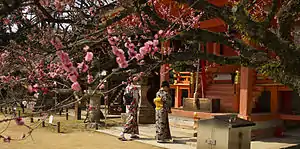
Shintoism is the ethnic religion of Japan, where shinto means 'Way of the Gods'. Shinto practitioners commonly affirm tradition, family, nature, cleanliness and ritual observation as core values.[36]
Ritual cleanliness is a central part of Shinto life.[37] Shrines have a significant in Shinto, being places for the veneration of the kami (gods or spirits).[38] 'Folk' or 'popular' Shinto features an emphasis on shamanism, particularly divination, spirit possession and faith healing. 'Sect' Shinto is a diverse group including mountain-worshippers and Confucian Shinto schools.[39]
Buddhism
.jpg.webp)
The countries of China, Japan, Korea, and Vietnam share a history of Mahayana Buddhism. It spread from India via the Silk Road through Pakistan, Xinjiang, eastward through Southeast Asia, Vietnam, then north through Guangzhou and Fujian. From China, it proliferated to Korea and Japan, especially during the Tang dynasty, especially through Kukai. It could have also re-spread from China south to Vietnam. East Asia is now home to the largest Buddhist population in the world at around 200-400 million.
Confucianism
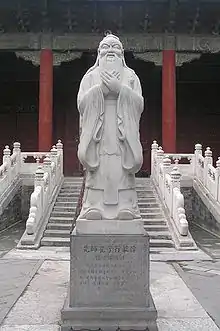

The countries of China, Japan, Korea, and Vietnam share a Confucian philosophical worldview.[18] Confucianism is a humanistic[40] philosophy that believes that human beings are teachable, improvable and perfectible through personal and communal endeavor especially including self-cultivation and self-creation. Confucianism focuses on the cultivation of virtue and maintenance of ethics, the most basic of which are:[41]
Neo-Confucianism
Mid-Imperial Chinese philosophy is primarily defined by the development of Neo-Confucianism. During the Tang dynasty, Buddhism from Nepal also became a prominent philosophical and religious discipline. Neo-Confucianism has its origins in the Tang dynasty; the Confucianist scholar Han Yu is seen as a forebear of the Neo-Confucianists of the Song dynasty.[42] The Song dynasty philosopher Zhou Dunyi is seen as the first true "pioneer" of Neo-Confucianism, using Daoist metaphysics as a framework for his ethical philosophy.[43]
Elsewhere in East Asia, Japanese philosophy began to develop as indigenous Shinto beliefs fused with Buddhism, Confucianism and other schools of Chinese philosophy. Similar to Japan, in Korean philosophy elements of Shamanism were integrated into the Neo-Confucianism imported from China. In Vietnam, neo-Confucianism was developed into Vietnamese own Tam giáo as well, along with indigenous Vietnamese beliefs and Mahayana Buddhism.
Other religions
Though not commonly identified with that of East Asia, the following religions have been influential in its history:
- Hinduism, see Hinduism in Vietnam, Hinduism in China
- Islam, Muslims in China, Islam in Hong Kong, Islam in Japan, Islam in Korea, Islam in Vietnam.
- Christianity, one of the most popular religions in South Korea and Singapore and after Buddhism. Significant Christian communities also found in China, Hong Kong, Japan, Macau, Taiwan and Vietnam.[44]
Language
Historical linguistics
Various languages are thought to have originated in East Asia and have various degrees of influence on each other. These include:
- Sino-Tibetan: Spoken mainly in China, Myanmar, Bhutan, Northeast India and parts of Nepal. Major Sino-Tibetan languages include the varieties of Chinese, the Tibetic languages and Burmese. They are thought to have originated around the Yellow River north of the Yangzi.[45][46]
- Austronesian: Spoken mainly in Taiwan, Indonesia, Madagascar, and the Pacific Islands. Major Austronesian languages include Malay (Indonesian and Malaysian), Javanese, and Filipino (Tagalog).
- Turkic: Spoken mainly in China, Russia, Central Asia, Turkey and Azerbaijan. Major Turkic languages include Turkish, Azerbaijani, Kazakh, Uzbek and Uyghur.[47][48][49]
- Austroasiatic: Spoken mainly in Vietnam and Cambodia. Major Austroasiatic languages include Vietnamese and Khmer.
- Kra-Dai: Spoken mainly in Thailand, Laos, and parts of Southern China. Major Kra-Dai languages include Thai and Lao.
- Mongolic: Spoken mainly in Mongolia, China and Russia. Major Mongolian languages include Mongolian, Monguor, Dongxiang and Buryat.
- Tungusic: Spoken mainly in Siberia and China. Major Tungusic languages include Evenki, Manchu, and Xibe.
- Koreanic: Spoken mainly in Korea. Major Korean languages include Korean, and Jeju.
- Japonic: Spoken mainly in Japan and Palau. Major Japonic languages include Japanese, Ryukyuan and Hachijo.
- Ainu language: Spoken mainly in Japan and considered an isolate.
The core Languages of the East Asian Cultural Sphere generally include the varieties of Chinese, Japanese, Korean, and Vietnamese. All of these languages have a well-documented history of having historically used Chinese characters, Japanese, Korean, and Vietnamese all having roughly 60% of their vocabulary stemming from Chinese.[50][51][52] There is a small set of minor languages that are comparable to the core East Asian languages such as Zhuang and Hmong-Mien. They are often overlooked since neither have their own country or heavily export their culture, but Zhuang has been written in hanzi inspired characters called Sawndip for over 1000 years. Hmong, while having supposedly lacked a writing system until modern history, is also suggested to have a similar percentage of Chinese loans to the core CJKV languages as well.[53]
While other languages have been impacted by the Sinosphere such as the Thai with its Thai numeral system and Mongolian with its historical use of hanzi: the amount of Chinese vocabulary overall is not nearly as expansive in these languages as the core CJKV, or even Zhuang and Hmong.
Various hypotheses are trying to unify various subsets of the above languages, including the Sino-Austronesian, Austric and Altaic language groupings.
Writing systems

East Asia is quite diverse in writing systems, from the Brahmic, inspired abugidas of SEA, the logographic hanzi of China, the syllabaries of Japan, and various alphabets and abjads used in Korea (Hangul), Mongolia (Cyrillic), Vietnam (Latin), Indonesia (Latin), etc.
| Writing system | Regions |
|---|---|
| Logograms 漢字 | Mainland China, Hong Kong, Macau, Japan, Korea, Singapore, Vietnam*, Taiwan |
| Syllabary (かな, kana) | Japan |
| Alphabet (Latin) | Singapore (Singapore English), Vietnam |
| Alphabet (한글, hangul) | Korea |
| Alphabet (Tâi-lô Latin script for Taiwanese Hokkien language) | Taiwan |
| Abugidas (Brahmic scripts of Indian origin) | Bhutan, China (Tibet, Xishuangbanna Dai Autonomous Prefecture) |
| Alphabet (Cyrillic) | Mongolia (though there is movement to switch back to Mongolian script)[54] |
| Alphabet (Mongolian) | Mongolia*, China (Inner Mongolia) |
| Abjad | China (Xinjiang) |
| * Official usage historically. Currently used unofficially. | |
Character influences
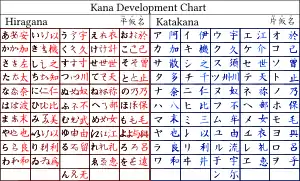
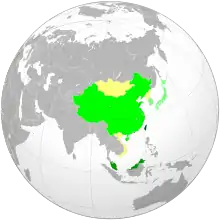
Hanzi (漢字 or 汉字) is considered the common culture that unifies the languages and cultures of many East Asian nations. Historically, Japan, Korea, and Vietnam have used Chinese characters. Today, they are mainly used in China, Japan, Korea and Singapore albeit in different forms. Vietnam now mostly use the Latin script, a consequence of colonization.
Mainland China, Malaysia and Singapore uses simplified characters, whereas Taiwan, Hong Kong, and Macau use traditional.
Japan still uses kanji but has also invented kana, believed to be inspired by the Brahmic scripts of southern Asia.
Korea used to write in hanja but has invented an alphabetic system called hangul (also inspired by Chinese and phags-pa during the Mongol Empire) that is nowadays the majority script. However, hanja is a required subject in South Korea. Names are also written in hanja. Hanja is also studied and used in academia, newspapers, and law; areas where a lot of scholarly terms and Sino-Korean loanwords are used and necessary to distinguish between otherwise ambiguous homonyms.
Vietnam used to write in chữ Hán or Classical Chinese. Since the 8th century they began inventing many of their own chữ Nôm. Since French colonization, they have switched to using a modified version of the Latin alphabet called chữ Quốc ngữ. However, Chinese characters still hold a special place in the cultures as their history and literature have been greatly influenced by Chinese characters. In Vietnam (and North Korea), hanzi can be seen in temples, cemeteries, and monuments today, as well as serving as decorative motifs in art and design. And there are movements to restore Hán Nôm in Vietnam. (Also see History of writing in Vietnam.)
Zhuang are similar to the Vietnamese in that they used to write in Sawgun (Chinese characters) and have invented many of their characters called Sawndip (Immature characters or native characters). Sawndip is still used informally and in traditional settings, but in 1957, the People's Republic of China introduced an alphabetical script for the language, which is what it officially promotes.[55]
Economy and trade
Before European imperialism, East Asia has always been one of the largest economies in the world, whose output had mostly been driven by China and the Silk Road.[56] During the Industrial Revolution, East Asia modernized and became an area of economic power starting with the Meiji Restoration in the late 19th century when Japan rapidly transformed itself into the only industrial power outside the North Atlantic area.[57] Japan's early industrial economy reached its height in World War II (1939-1945) when it expanded its empire and became a major world power.
The business cultures within the Sinosphere in some ways are heavily influenced by Chinese culture. Important in China is the social concept of guanxi (關係), which has influenced the societies of Korea, Vietnam and Japan as well.[58] Japan often features hierarchically-organized companies, and Japanese work environments place a high value on interpersonal relationships.[56] Korean businesses, adhering to Confucian values, are structured around a patriarchal family governed by filial piety (孝順) between management and a company's employees.[58]
Post-WW2 (Tiger economies)
Following Japanese defeat, economic collapse after the war, and US military occupation, Japan's economy recovered in the 1950s with the post-war economic miracle in which rapid growth propelled the country to become the world's second-largest economy by the 1980s.
Since the Korean War and again under US military occupation, South Korea has experienced its postwar economic miracle called the Miracle on the Han River, with the rise of global tech industry leaders like Samsung, LG, etc. As of 2019 its economy is the 4th largest in Asia and the 11th largest in the world.
Hong Kong became one of the Four Asian Tiger economies, developing strong textile and manufacturing economies.[59] South Korea followed a similar route, developing the textile industry.[59] Following in the footsteps of Hong Kong and Korea, Taiwan and Singapore quickly industrialized through government policies. By 1997, all four of the Asian Tiger economies had joined Japan as economically developed nations.[59]
As of 2019, South Korean and Japanese growth have stagnated (see also Lost Decade), and present growth in East Asia has now shifted to China and to the Tiger Cub Economies of Southeast Asia.[60][61][62][63]
Modern era
Since the Chinese economic reform, China has become the 2nd and 1st-largest economy in the world respectively by nominal GDP and GDP (PPP). The Pearl River Delta is one of the top startup regions (comparable with Beijing and Shanghai) in East Asia, featuring some of the world's top drone companies, such as DJI.
Up until the early 2010s, Vietnamese trade was heavily dependent on China, and many Chinese-Vietnamese speak both Cantonese and Vietnamese, which share many linguistic similarities. Vietnam, one of Next Eleven countries as of 2005, is regarded as a rising economic power in Southeast Asia.[64]
East Asia participates in numerous global economic organizations including:
See also
- Sinosphere (linguistics)
- Adoption of Chinese literary culture
- East Asia
- Sinophone world
- Sinoxenic
- Asian values
- Culture of Bhutan
- Culture of China
- Chinese influence on Korean culture
- Chinese influence on Japanese culture
- Culture of Hong Kong
- Culture of Japan
- Culture of Korea
- Culture of Macau
- Culture of Malaysia
- Culture of Mongolia
- Culture of Singapore
- Culture of Taiwan
- Culture of Vietnam
- List of tributary states of China
- List of Confucian states and dynasties
- Pax Sinica
- Four Asian Tigers
- Greater East Asia Co-Prosperity Sphere
- Sojunghwa
References
Citations
- Jeffrey L. Richey (2013). Confucius in East Asia: Confucianism's History in China, Korea, Japan, and Vietnam. Association for Asian Studies. ISBN 978-0924304736., Rutgers University, ed. (2010). East Asian Confucianism: Interactions and Innovations. Rutgers University. ISBN 978-0615389325.CS1 maint: extra text: authors list (link)Chun-chieh Huang, ed. (2015). East Asian Confucianisms: Texts in Contexts. National Taiwan University Press and Vandenhoeck & Ruprecht. ISBN 9783847104087.CS1 maint: extra text: authors list (link)
- Kang, David C. (David Chan-oong), 1965- (2012). East Asia before the West : five centuries of trade and tribute (Paperback ed.). New York: Columbia University Press. ISBN 978-0-231-15319-5. OCLC 794366373.CS1 maint: multiple names: authors list (link)
- Benjamin A Elman, ed (2014). Rethinking East Asian Languages, Vernaculars, and Literacies, 1000–1919. Brill. ISBN 978-9004279278.CS1 maint: extra text: authors list (link)
- Nanxiu Qian et al, eds (2020). Rethinking the Sinosphere: Poetics, Aesthetics, and Identity Formation. Cambria Press. ISBN 978-1604979909.CS1 maint: extra text: authors list (link)
- Nanxiu Qian et al, eds (2020). Reexamining the Sinosphere: Cultural Transmissions and Transformations in East Asia. Cambria Press. ISBN 978-1604979879.CS1 maint: extra text: authors list (link)
- L. Carrington Goodrich (2007). A Short History of the Chinese People. Sturgis Press. ISBN 978-1406769760.
- McCannon, John (19 March 2018). Barron's how to Prepare for the AP World History Examination. Barron's Educational Series. ISBN 9780764118166.
- Formichi, Chiara (1 October 2013). Religious Pluralism, State and Society in Asia. Routledges. ISBN 9781134575428.
- Sthapitanond, Nithi; Mertens, Brian (19 March 2018). Architecture of Thailand: A Guide to Tradition and Contemporary Forms. Editions Didier Millet. ISBN 9789814260862.
- Winks, Robin (21 October 1999). The Oxford History of the British Empire: Volume V: Historiography. OUP Oxford. ISBN 9780191542411.
- Rodriguez T. Senase, Jose (25 July 2019). "Qingdao Airlines launches inaugural flight to Sihanoukville". Khmer Times. Retrieved 25 July 2019.
- Rieffel, Lex (2010). Myanmar/Burma: inside challenges, outside interests. Brookings Institution Press. pp. 95–97. ISBN 978-0-8157-0505-5.
- Wang Hui, "'Modernity and 'Asia' in the Study of Chinese History," in Eckhardt Fuchs, Benedikt Stuchtey, eds.,Across cultural borders: historiography in global perspective (Rowman & Littlefield, 2002 ISBN 978-0-7425-1768-4), p. 322.
- Victor Mair, Sinophone and Sinosphere, Language Log, November 8, 2012.
- See the "family tree" of Toynbee's "civilizations" in any edition of Toynbee's work, or e.g. as Fig.1 on p.16 of: The Rhythms of History: A Universal Theory of Civilizations, By Stephen Blaha. Pingree-Hill Publishing, 2002. ISBN 0-9720795-7-2.
- Sun, Lung-kee (2002). The Chinese National Character: From Nationalhood to Individuality. M.E. Sharpe. p. 154. ISBN 978-0-7656-3936-3.
- Sun, Lung-kee (2002). The Chinese National Character: From Nationalhood to Individuality. M.E. Sharpe. p. 188. ISBN 978-0-7656-0826-0.
- Edwin O. Reischauer, "The Sinic World in Perspective," Foreign Affairs 52.2 (January 1974): 341-348. JSTOR
- The Clash of Civilizations and the Remaking of World Order. (New York: Simon & Schuster, 1996; ISBN 0684811642), p. 45
- William E. Davis (2006). Peace And Prosperity in an Age of Incivility. University Press of America. p. 197. ISBN 978-0-7618-3248-5.
- Michail S. Blinnikov (2011). A Geography of Russia and Its Neighbors. Guilford Press. p. 132. ISBN 978-1-60623-933-9.
- Lung-kee Sun (2002). The Chinese National Character: From Nationalhood to Individuality. M.E. Sharpe. p. 32. ISBN 978-0-7656-0826-0.
- Hugh Gusterson (2004). People of the bomb: portraits of America's nuclear complex. U of Minnesota Press. p. 124. ISBN 978-0-8166-3860-4.
- McCannon, John (February 2002). How to Prepare for the AP World History. ISBN 9780764118166.
- Davidson, Alan (1981). Food in Motion: The Migration of Foodstuffs and Cookery Techniques : Proceedings : Oxford Symposium 1983. Oxford Symposium. p. 22. ISBN 978-0-907325-07-9.
- Wen S. Chern; Colin A. Carter; Shun-yi Shei (2000). Food security in Asia: economics and policies. Edward Elgar Publishing. p. 2. ISBN 978-1-78254-334-3.
- Kim, Kwang-Ok (1 February 2015). Re-Orienting Cuisine : East Asian Foodways in the Twenty-First Century. Berghahn Books, Incorporated. p. 14. ISBN 9781782385639.
- Adi, Yoga (13 July 2017). "Top 8 Chinese Culture in Indonesia". Facts of Indonesia (in Indonesian). Retrieved 27 April 2019.
- Kornicki, P.F. (2011), "A transnational approach to East Asian book history", in Chakravorty, Swapan; Gupta, Abhijit (eds.), New Word Order: Transnational Themes in Book History, Worldview Publications, pp. 65–79, ISBN 978-81-920651-1-3.Kornicki 2011, pp. 75–77
- Fogel (1997), p. 686.
- Kornicki (2011), pp. 66–67.
- Miyake (2004), pp. 98–99.
- Kornicki (2011), p. 68.
- "Given Japan’s strong tradition of Chinese textual scholarship, encouraged further by visits by eminent Chinese scholars since the early twentieth century, Japan has been one of the birthplaces of modern sinology outside China" Early China - A Social and Cultural History, page 11. Cambridge University Press.
- Robinet (1997), p. 3; Kohn (2000), p. xi
- Ono, Sakyo. Shinto: The Kami Way. Pp 97–99, 103–104. Tuttle Publishing. 2004. ISBN 0-8048-3557-8
- Ono, Sakyo. Shinto: The Kami Way. Pp 51–52, 108. Tuttle Publishing. 2004. ISBN 0-8048-3557-8
- Markham, Ian S. & Ruparell, Tinu. Encountering Religion: an introduction to the religions of the world. pp 304–306 Blackwell Publishing, 2001. ISBN 0-631-20674-4.
- Ono, Sakyo. Shinto: The Kami Way. Pg 12. Tuttle Publishing. 2004. ISBN 0-8048-3557-8
- Juergensmeyer, Mark (2005). Religion in global civil society. Oxford University Press. p. 70. ISBN 978-0-19-518835-6.
- Craig, Edward. Philosophy: A Very Short Introduction. ISBN 0-19-285421-6 Craig 1998, p. 536.
- Essentials of Neo-Confucianism: Eight Major Philosophers of the Song and Ming Periods by Huang, Siu-chi. Huang 1999, p. 5.
- A Sourcebook of Chinese Philosophy by Chan, Wing-tsit. Chan 2002, p. 460.
- Analysis (19 December 2011). "Global Christianity". Pew Research Center. Retrieved 17 August 2012.
- Jin, Li; Wuyun Pan; Yan, Shi; Zhang, Menghan (24 April 2019). "Phylogenetic evidence for Sino-Tibetan origin in northern China in the Late Neolithic". Nature. 569 (7754): 112–115. Bibcode:2019Natur.569..112Z. doi:10.1038/s41586-019-1153-z. ISSN 1476-4687. PMID 31019300. S2CID 129946000.
- Sagart, Laurent and Jacques, Guillaume and Lai, Yunfan and Ryder, Robin and Thouzeau, Valentin and Greenhill, Simon J. and List, Johann-Mattis. 2019. "Dated language phylogenies shed light on the ancestry of Sino-Tibetan". Proceedings of the National Academy of Sciences of the United States of America 21. 10317-10322. doi:10.1073/pnas.1817972116
- Yunusbayev, Bayazit; Metspalu, Mait; Metspalu, Ene; et al. (21 April 2015). "The Genetic Legacy of the Expansion of Turkic-Speaking Nomads across Eurasia". PLOS Genetics. 11 (4): e1005068. doi:10.1371/journal.pgen.1005068. ISSN 1553-7390. PMC 4405460. PMID 25898006.
Thus, our study provides the first genetic evidence supporting one of the previously hypothesized IAHs to be near Mongolia and South Siberia.
- Blench, Roger; Spriggs, Matthew (2003). Archaeology and Language II: Archaeological Data and Linguistic Hypotheses. Routledge. p. 203. ISBN 9781134828692.
- "Transeurasian theory: A case of farming/language dispersal". ResearchGate. Retrieved 13 March 2019.
- DeFrancis, John, 1911-2009. (1977). Colonialism and language policy in Viet Nam. The Hague: Mouton. ISBN 9027976430. OCLC 4230408.CS1 maint: multiple names: authors list (link)
- Sohn, Ho-min. (1999). The Korean language. Cambridge, UK: Cambridge University Press. ISBN 0521361230. OCLC 40200082.
- Shibatani, Masayoshi. (1990). The languages of Japan. 柴谷, 方良, 1944- (Reprint 1994 ed.). Cambridge [England]: Cambridge University Press. ISBN 0521360706. OCLC 19456186.
- Ratliff, Martha Susan. (2010). Hmong-Mien language history. Pacific Linguistics. ISBN 9780858836150. OCLC 741956124.
- "Why reading their own language gives Mongolians a headache". SoraNews24. 26 September 2013. Retrieved 27 April 2019.
- Zhou, Minglang, 1954- (24 October 2012). Multilingualism in China : the politics of writing reforms for minority languages, 1949-2002. Berlin. ISBN 9783110924596. OCLC 868954061.CS1 maint: multiple names: authors list (link)
- Where cultures meet; a cross-cultural comparison of business meeting styles. Hogeschool van Amsterdam. p. 69. ISBN 978-90-79646-17-3.
- Aiko Ikeo (4 January 2002). Economic Development in Twentieth-Century East Asia: The International Context. Taylor & Francis. p. 12. ISBN 978-0-203-02704-2.
- Timothy Book; Hy V.. Luong (1999). Culture and economy: the shaping of capitalism in eastern Asia. University of Michigan Press. p. 131. ISBN 978-0-472-08598-9. Retrieved 26 May 2013.
- Compare: J. James W. Harrington; Barney Warf (1995). Industrial Location: Principles, Practice, and Policy. Routledge. p. 199. ISBN 978-0-415-10479-1.
As the textile industry began to abandon places with high labor costs in the western industrialized world, it began to sprout up in a variety of Third World locations, in particular the famous 'Four Tiger' nations of East Asia: South Korea, Taiwan, Hong Kong, and Singapore. Textiles were particularly important in the early industrialization of South Korea, while garment production was more significant to Hong Kong.
- "Why South Korea risks following Japan into economic stagnation". Australian Financial Review. 21 August 2018. Retrieved 27 April 2019.
- Abe, Naoki (12 February 2010). "Japan's Shrinking Economy". Brookings. Retrieved 27 April 2019.
- "The rise and demise of Asia's four little dragons". South China Morning Post. 28 February 2017. Retrieved 27 April 2019.
- "YPs' Guide To: Southeast Asia—How Tiger Cubs Are Becoming Rising Tigers". spe.org. Retrieved 27 April 2019.
- "The story behind Viet Nam's miracle growth". World Economic Forum. Retrieved 27 April 2019.
Sources
- Ankerl, Guy (2000). Coexisting contemporary civilizations : Arabo-Muslim, Bharati, Chinese, and Western. Global communication without universal civilization. 1. Geneva, Switzerland: INU Press. ISBN 978-2-88155-004-1.
- Elman, Benjamin A (2014). Rethinking East Asian Languages, Vernaculars, and Literacies, 1000–1919. Leiden: Brill. ISBN 978-9004279278.
- Joshua Fogel, "The Sinic World," in Ainslie Thomas Embree, Carol Gluck, ed., Asia in Western and World History a Guide for Teaching. (Armonk, N.Y.: M.E. Sharpe, Columbia Project on Asia in the Core Curriculum, 1997). ISBN 0585027331. Access may be limited to NetLibrary affiliated libraries.
- Fogel, Joshua A. (2009). Articulating the Sinosphere : Sino-Japanese relations in space and time. Edwin O. Reischauer Lectures ([Online-Ausg.] ed.). Cambridge, Mass.: Harvard University Press. ISBN 978-0-674-03259-0.
- Holcombe, Charles (2011). "Introduction: What is East Asia". A history of East Asia : from the origins of civilization to the twenty-first century (1st published. ed.). Cambridge, England: Cambridge University Press. pp. 1–10. ISBN 978-0521731645.
- —— (2001). The Genesis of East Asia, 221 B.C.-A.D. 907 ([Online-Ausg.] ed.). Honolulu: Association for Asian Studies and University of Hawai'i Press. ISBN 978-0824824150.
- Huang, Chun-chieh (2015). East Asian Confucianisms: Texts in Contexts. Taipei and Göttingen, Germany: National Taiwan University Press and Vandenhoeck & Ruprecht. ISBN 9783847104087.
- Qian, Nanxiu (2020). Reexamining the Sinosphere: Cultural Transmissions and Transformations in East Asia. Amherst, N.Y.: Cambria Press. ISBN 978-1604979879. Lay summary.
- —— (2020). Rethinking the Sinosphere: Poetics, Aesthetics, and Identity Formation. Amherst, NY: Cambria Press. ISBN 978-1604979909. Lay summary.
- Reischauer, Edwin O. (1974). "The Sinic World in Perspective". Foreign Affairs. 52 (2): 341–348. doi:10.2307/20038053. JSTOR 20038053.
- Richey, Jeffrey L. (2013). Confucius in East Asia: Confucianism's History in China, Korea, Japan, and Vietnam. Ann Arbor: Association for Asian Studies. ISBN 978-0924304736. Lay summary.
- Rutgers University, Confucius Institute (2010). East Asian Confucianism: Interactions and Innovations. New Brunswick, NJ: Rutgers University. ISBN 978-0615389325. Lay summary.
External links
- Asia for Educators. Weatherhead East Asian Institute, Columbia University.
.svg.png.webp)